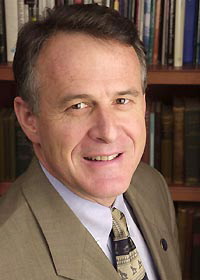For more archives, go to the Advance Archive/Search Page.
The Academic Plan provides the University with a roadmap for making strategic decisions that will enable us to target our energies and our recources toward identifiable areas of excellence.
At the Board of Trustees meeting on March 23, I had the opportunity to outline for the Board our plans for capital spending over the next several years. The discussion of the sequencing of projects for the remainder of the UConn 2000 program, as well as preliminary planning for 21st Century UConn, required that we look critically at the present state of our buildings against our desire to continue to move UConn academically to among the top universities in the nation.
 |
|
Provost John D. Petersen |
Moving forward, our capital allocations will tie directly to our Academic Plan, while continuing to address building replacement dictated by safety or necessity based on enrollment demands.
On March 19, Suman Singha joined my staff as the new vice provost for academic programs. His activities will focus primarily on the implementation of the Academic Plan, including the development of the Provost's Grant Competition. He brings a wealth of experience in research and administration, in addition to a whole host of other qualities that will benefit my office, and ultimately the University, in myriad ways.
Fred Maryanski, senior vice provost for academic affairs, Vice Provost Singha, and I will work closely with the deans and vice provosts in identifying critical areas of opportunity and exploiting these opportunities to their fullest potential.
Both of these developments bring us steps closer to realizing a directed approach to strategic investment in the University. Growth alone, whether in funding or program size, does not necessarily indicate long-term success.
The six areas of choice outlined in the Academic Plan are a roadmap that will allow us to focus our energies and resources on specific, identifiable areas of excellence. We need to look critically in order to honestly assess where we are and where we can go, given our current financial climate, external sources of resources, and trend data on emerging technologies and industries.
Historically, such world-class programs as the Center for HIV Intervention and Prevention and the Connecticut Fuel Cell Center have been established on an ad hoc basis. The guiding principles of the Academic Plan will provide a framework by which we can focus our energies and resources to build programs that enhance the overall quality of the university. This framework will also guide assessment of other areas of growth, and allow us to move forward with planning for success in an orderly fashion. Vice Provost Singha will guide this process, and will work in a collaborative way with faculty from across all campuses, to be as inclusive as possible.
Like other institutions of higher education across the country, we are, and will continue to be, faced with having to make tough choices about our future. Business as usual cannot continue. We will be faced with decisions about divesting in some areas while at the same time investing in others. This critical self-assessme nt may, at times, be painful and unpleasant, but it is necessary for our long-term health.
Our obligations to our students, our faculty, and our state's economy demand that we look across all areas and focus on those that bring the greatest return on our investment.

